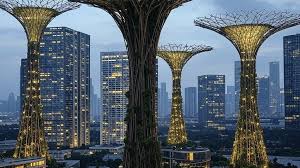
Building Skyscrapers with 3D Printers – Yes, It’s Real
Imagine towering skyscrapers rising not from cranes and bricks but from gigantic 3D printers—layer by layer, automated, and faster than ever before. What once seemed like futuristic science fiction is now becoming reality, transforming the construction industry in ways we never imagined.
Yes, building skyscrapers with 3D printing technology is real—and it promises to revolutionize how we design, build, and live in cities around the world.
🏗️ What Is 3D Printing in Construction?
3D printing, also called additive manufacturing, builds objects by depositing material layer upon layer, based on a digital design.
In construction, 3D printers use special concrete mixtures or other building materials to “print” walls, beams, and even entire structural components.
Unlike traditional methods, this process can reduce waste, cut costs, and speed up building timelines dramatically.
🌇 From Small Houses to Skyscrapers
While 3D printing in construction started with small homes and architectural models, recent breakthroughs are scaling this up to multi-story buildings and skyscrapers.
-
China and the United Arab Emirates have already printed multi-story buildings using massive 3D printers mounted on robotic arms.
-
In the U.S., companies are developing modular 3D printed components that can be assembled into high-rise structures.
-
The technology allows for complex architectural designs that are hard or impossible to achieve with traditional construction.
⚙️ How Does It Work for Skyscrapers?
Building skyscrapers with 3D printing involves:
-
Digital Modeling: Architects and engineers create a 3D model with precise specifications.
-
Material Preparation: Special concrete or composite materials are formulated for strength and quick setting.
-
Layer-by-Layer Printing: Large-scale robotic arms or gantries deposit the material layer by layer to form walls, supports, and structural elements.
-
Assembly & Finishing: Printed components may be combined with traditional materials (steel frameworks, glass) and finished by workers on-site.
🚀 Why 3D Printing Skyscrapers Is a Game-Changer
1. Speed
3D printing can reduce construction time from months or years to weeks by automating repetitive processes.
2. Cost Efficiency
Less manual labor and less material waste mean lower costs—critical for affordable urban housing.
3. Design Freedom
Architects can experiment with complex, organic shapes and integrated features like ventilation channels—without added expense.
4. Sustainability
Using less concrete, recycling materials, and minimizing waste contribute to eco-friendly construction.
🏙️ Real-World Examples
-
In 2022, WinSun in China printed a 10-story apartment building, one of the tallest structures made this way.
-
The Dubai Municipality unveiled a 3D-printed office building—functional, innovative, and built in record time.
-
U.S. startup Apis Cor is developing 3D printed building technologies that could be scaled to skyscrapers in the near future.
⚠️ Challenges to Overcome
While the future is bright, challenges remain:
-
Material Strength & Durability: Printed materials must meet strict safety and engineering standards for tall buildings.
-
Regulation & Codes: New building codes must adapt to 3D printed structures.
-
Scale & Machinery: Printing entire skyscrapers requires massive machines and careful logistics.
-
Integration: Combining printed elements with traditional construction materials and utilities is complex.
🔮 The Future of Urban Living?
Imagine cities with custom-designed skyscrapers built in weeks, tailored to environmental conditions, and created with minimal environmental impact.
3D printing could democratize urban development, allowing rapid housing in disaster zones, affordable urban renewal, and innovative architectural landmarks.
🧠 Final Thought
Building skyscrapers with 3D printers is no longer a fantasy—it’s an emerging reality pushing the boundaries of construction technology.
As the technology matures, it could redefine how we build the cities of tomorrow: faster, cheaper, greener, and more creative than ever before.
The skyscraper of the future might just rise from the nozzle of a giant 3D printer.